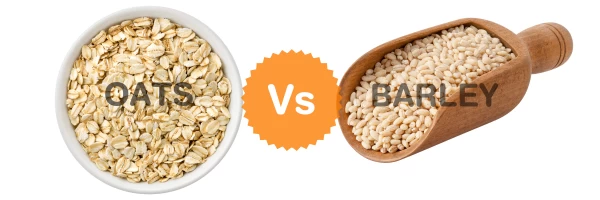Oats vs Barley (Jai)
Table of Contents

Oats vs Barley (Jai)
High levels of fibre and protein, as those found in oats and barley (Jai), can aid with weight loss by making you feel full on fewer calories.
Oats, on the other hand, may be marginally more helpful for weight loss due to their higher beta-glucan content. This soluble fibre has been demonstrated to have special benefits for weight control. Increased fullness and satiety, decreased hunger, and decreased blood sugar levels are all benefits of consuming beta-glucan.
Oats and barley, when consumed in moderation and as part of a diet that includes a range of complete foods, can be beneficial additions to a weight loss plan. Watch your serving sizes and cut back on the extra sugar and high-calorie toppings while eating these grains.
| Characteristics | Oats | Barley (Jai) |
| Scientific Name | Avena sativa | Hordeum vulgare |
| Appearance | Flattened, oval-shaped grains | Elongated, oval-shaped grains |
| Nutritional Value (per 100g) | Calories - 389 Protein - 16.9g Carbs - 66.3g Fiber - 10.6g Fat - 6.9g Thiamine - 1.2mg Riboflavin - 0.2mg Niacin - 1.1mg Vitamin B6 - 0.6mg Calcium - 56mg Magnesium - 177mg Phosphorus - 429mg Iron - 4.7mg Zinc - 3.6mg | Calories - 354 Protein - 12.5g Carbs - 73.5g Fiber - 17.3g Fat - 2.3g Thiamine - 0.2mg Riboflavin - 0.1mg Niacin - 3.1mg Vitamin B6 - 0.3mg Calcium - 33mg Magnesium - 133mg Phosphorus - 452mg Iron - 2.5mg Zinc - 2.2mg |
| Glycemic Index | 55 (low) | 28 (low) |
| Gluten Content | May contain gluten | Contains gluten |
| Taste | Mild, slightly sweet | Nutty, chewy |
| Texture | Soft | Chewy |
| Uses | Oatmeal, granola, baked food items, etc. | Soups, stews, risotto, beer, etc. |
| Culinary Properties | Can be cooked in various ways, including boiled, baked, and microwaved | Often used in soups and stews as a thickener or to add flavor and texture |
| Health Benefits | High in fiber, protein, and micronutrients; may help lower cholesterol levels and reduce the risk of heart disease | High in fiber, low glycemic index, and may help regulate blood sugar levels; may also have anti-inflammatory and cholesterol-lowering effects |
| Suitable for | Vegetarian and vegan diets | Vegetarian and vegan diets |
| Allergies and Sensitivities | May cause allergic reactions in some people with gluten intolerance or celiac disease | May cause allergic reactions in some people with gluten intolerance or celiac disease |
| Availability | Widely available in supermarkets, health food stores and online grocery store. | Widely available in supermarkets, health food stores and online grocery store |
| Storage | Store in a cool, dry place in an airtight container | Store in a cool, dry place in an airtight container |
| Shelf Life | Several months to a year | Several months to a year |
| Price | Affordable | Affordable |
| Production | Grown in many regions of the world, including North America, Europe, and Australia | Grown in many regions of the world, including North America, Europe, and Asia |
| Environmental Impact | Requires less water and fertilizer than some other grains | Can be used as a cover crop to improve soil quality |
| Other Uses | Used in cosmetics and personal care products | Used in animal feed |
| Cultural Significance | Used in traditional dishes such as oatcakes and haggis in Scotland | Used in traditional dishes such as barley soup and kasha in Eastern Europe |
Other food items with beta-glycans
Oats and barley are particularly rich sources of beta-glucan, a soluble fibre found in many plant-based meals. The approximate beta-glucan content of some other foods that are good sources is listed below.
Food | Beta-Glucan Content |
Oat bran (1/3 cup cooked) | 3 grams |
Rolled oats (1/2 cup dry) | 2-3 grams |
Steel-cut oats (1/2 cup dry) | 3-4 grams |
Barley (1/2 cup cooked) | 3-4 grams |
Whole grain rye bread (1 slice) | 0.5-1 gram |
Shiitake mushrooms (1 cup cooked) | 0.5-1 gram |
Seaweed (1/4 cup dried) | 0.5-1 gram |
Brewer's yeast (1 tablespoon) | 0.4 grams |
Chia seeds (1 tablespoon) | 0.4 grams |
Flaxseed (1 tablespoon) | 0.2 grams |
The beta-glucan content of a given food item may differ based on its type, processing method, or even the weather during its growth season. The health advantages of beta-glucan are connected with its consumption, which can be increased by eating certain foods.

